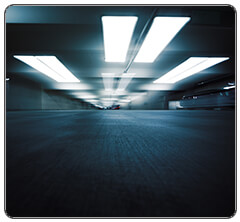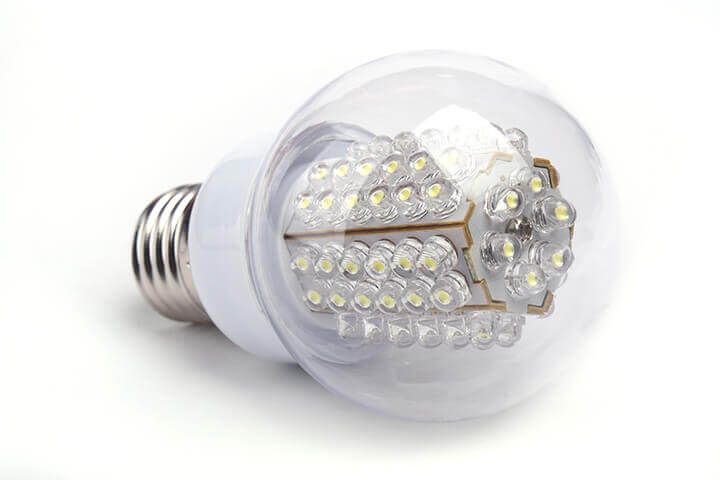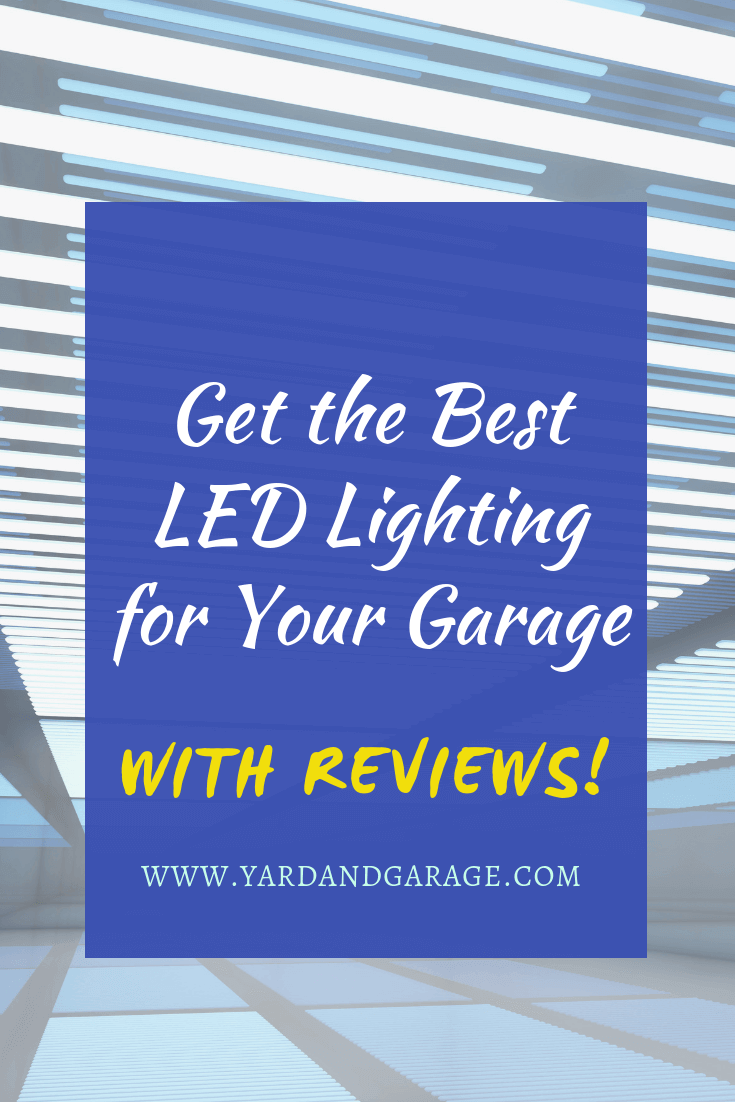 Proper garage lighting is a high priority for those of us who spend a lot of quality time working on home repair projects, maintaining our vehicles, or engaging in a hobby.
Proper garage lighting is a high priority for those of us who spend a lot of quality time working on home repair projects, maintaining our vehicles, or engaging in a hobby.
Your best option for longevity and a manageable electric bill is LED lights. Shopping for garage lighting isn’t a task many want to spend a lot of time on so hopefully this guide will help you out.
I’ve put together a review of some of the top-selling light-emitting diodes (LED) lighting kits so you can make the best decision for your garage and your budget. Here are my picks for the best LED garage lights.
Table of Contents
Quick Comparison
[amazon table=”824″]
[amazon table=”825″]
#1. Airand 4 ft. Linkable Garage Shop Lights
Low power, Linkable 4 foot strips. More flexibility for your lighting solutions.
Light Review:
The [amazon link=”B07X7WQYY4″ title=”Airand 4 foot LED shop light” link_icon=”amazon” /] is perfect for all those dark spaces that need a little brightness. They are great in garages, workshops or where ever else you need some extra illumination. Plug it in while you go do other things and before you know it, the room will be brightened up as never before.
The high output LEDs don’t take up much energy so your electric bill stays at an affordable level even during peak hours of use! There’s not much they can’t handle…basement, garage, workshop and utility room included!
The single set does just enough to light up a small area, and link two sets together if you need more light. Modular design allows you to combine as many units (in different shapes too!) as needed to reach the desired amount of brightness in your workplace.
Hyperikon Pros
- 3,600 lumens
- Link up to 10 units together
- Anti-glare frosted covering
Hyperikon Cons
- Linking cord could be unsightly.
- Brighter options available
#2. Striker Concepts 00342 3000 Lm Motion-Activated Ceiling Light
Unique Lighting System
[amazon box=”B01LX4ZTYI”]
Lighting Review:
If nothing else, [amazon link=”B01LX4ZTYI” title=”the Striker light system” link_icon=”amazon” /] is different in that it is not the traditional rectangular model. This is a good tri-light model with adjustable heads. Installation is simple – all you do is remove an existing bulb, replace it with this tri-light system and screw it in. That really is all there is to it.
And for those of you that are environmentally focused, you can get more light with less energy at 3,000 lumens at only 25 watts. The adjustable heads will allow you to focus the light in whichever areas you need.
These lights are more expensive than the others on our list, especially on a per lumen basis. And while this lighting system comes with a motion sensor it appears to be extremely sensitive and off-putting to a lot of users.
And given its installation, you won’t be able to link multiple units over the space that requires illumination.
Striker Pros
- Adjustable heads
- Economical cost per lumen
- Extremely easy installation
Striker Cons
- Motion sensor super sensitive
- Light output may be insufficient
#3. Lithonia Lighting SGLL 24 40K 80CRI PIR M4 LED Garage Light with Motion Sensor
Too Many Features for a Homeowner’s Garage Light System?
[amazon box=”B01L9NMB94″]
Review:
Lithonia is a well-known name and has several great models of lighting systems. [amazon link=”B01L9NMB94″ title=”This particular model” link_icon=”amazon” /] produces 5,000 lumens but only requires 80 watts to do it. It has a 360-degree motion sensor with the ability to preset the automatic timer at 1-10 minutes.
It can be installed using either the included suspension or flush to the ceiling. The unit claims an average life of 50,000 hours and also has a limited 5-year warranty.
For these reasons, we think this unit by Lithonia is a contender for the best LED garage lights title.
Unlike other models, this unit is smaller at only 24 inches whereas other models are generally in the 48-inch range. Also, while these units can be linked together it is limited to a maximum of two units.
And as with most systems, you’ll probably need an extension cord to complete the installation.
The cost per unit is also much more expensive especially considering the number of watts required. Multiple users have also reported an unsightly yellow tinge in the lighting which they have found offputting.
Pros
- A 360-degree motion sensor
- High-efficiency driver
- 5,000 lumen
Cons
- High cost per lumen
- Yellow cast to lighting
- Can only link two units
#4. Hykolity 4FT 40W Linkable LED Shop Light with Pull Chain
4800lm Surface Mount/Hanging Garage Utility Light with cord, 5000K Workbench Light, 64w Fluorescent Fixture Replacement, ETL and DLC listed
Review:
You may have heard of Hykolity and their UFO commercial lighting, but I am impressed with this super bright garage system (check price on Amazon). At 40 watts, this light produces 4,800 lumens which is one of the brightest options we have seen.
Are you ready to save money and get more light in your workspace? Additionally, this Hykolity system like others that we have reviewed, has the ability to link multiple units together.
However, this system can link up to 20 units to cover even the largest of garages.
These lights boast a 50,000-hour life, have an aluminum composite body and a limited 5-year warranty. The primary complaint that users have is that the packaging used in delivering the system is flimsy and can result in a damaged product. In those instances, customer service has proven to be friendly and quick in supplying replacement products.
Pros
- Link up to 20 units
- 4,800 lumens
- Easy to install
- Low-cost option
Cons
- Non-durable packaging
#5. Leonlite 4ft Linkable LED Motion Activated Utility Shop Light
40W (120W T8 Tubes Equiv.) LED Ceiling Fixture, 4100lm, Energy Star & ETL Listed, 4000K Cool White, for Garage/Basement/Workshop
Review:
Leonlite is a relative newcomer into the garage LED lighting business but they have already managed to produce a best-selling system at a great price. They also produce a motion-activated light, and as we have seen with other systems, they can be linked together to cover a larger area.
Their best LED model we have found is the 4ft Linkable kit. What is special about this shop light (check price on Amazon) is that the lights are not merely linkable but can be installed flush with one another, giving them a sleek appearance and ability to fit into tight spaces.
The output is a little over 4,000 lumens at only 40 watts and has a daylight option in addition to the cool white. In addition to the traditional mounting system, one can also use the chain system as well.
A traditional pull cord is also available to turn the unit on or off. Also as we’ve seen with the other systems you’ll most likely need an extension cord if the lights are centrally placed.
Pros
- Flush mount
- Great light output
- Simple installation
Cons
- Motion sensor may be unreliable
- Cheaper housing materials
What are the Advantages of Using LED Lights in the Garage?
The age of the incandescent light bulb is fast drawing to a close. It’s been a good run, and this seemingly simple invention has helped change the world beyond recognition over the last century or so.

However, traditional bulbs are highly inefficient and overly fragile, and while various new lighting technologies have been developed to fix these problems, each had their downsides and failed to make enough impact to overturn the dominance of the incandescent.
Modern LED lighting could be the technology that sounds the death knell for traditional lights, however, thanks to its excellent combination of cost-savings, convenience, and attractive light quality. Why do we think LED bulbs fit the bill for best garage lights?
LED Lights are Efficient
- LED lamps offer reliability and a long life, typically lasting 50,000 hours compared to 1,000 for a traditional bulb. Instead of constantly replacing bulbs throughout your home, you can plug LEDs in and then largely forget them.
- LED lamps use less than a tenth of the energy of traditional bulbs while providing the same bright lighting power. That is good for both your energy bills and for the environment.
- They’re also eco-friendly in other ways. LED bulbs are fully recyclable, and contain none of the poisonous materials such as mercury that old lighting methods use.
LEDs Have a Long Lifespan
- LED bulbs are also extremely durable. They won’t fail during an electrical surge, and all but the most violent knock will do them little damage. Also, as LED lamps age, their brightness diminishes rather than simply blowing out, giving you plenty of time to stock replacements.
- LED light works on a tightly controlled wavelength, meaning there are less harmful UV emissions and less energy wastage through heat.
They Provide Good Lighting at a Great Price
- The cost of an LED bulb has plummeted over the last few years. You can now buy a generic bulb for less than $5, which considering the long life and low energy usage makes LED an extremely economical lighting method.
- Modern LED lighting gives a warm and comfortable glow, in contrast to the harsher, colder light which was typical of previous energy-saving devices. These fittings can now be dimmed in intensity as you wish, and the light’s color temperature can even be varied to suit your tastes.
Edison’s brainchild, the incandescent bulb, has survived for well over a century thanks to its convenience and the comfortingly warm quality of its light. Newer technologies have never entirely displaced older bulbs in the public’s affections, with each type suffering from distinct drawbacks.
Modern LED lighting seems set to change all that, with all the major problems overcome, and massive improvements made in energy efficiency and cost. Is it time you considered switching?
LED Lighting: Why Should You Consider Using it in Your Next Home Decor Project?
The traditional incandescent light bulb has been around, largely unchanged in design, for nearly 150 years. This is despite its drawbacks. High fragility and energy-inefficiency are just two of many good reasons for leaving traditional bulbs behind.

Although replacement technologies such as halogen have failed to gain widespread popularity, it looks as though LED lighting might finally be the lighting solution to challenge the old-fashioned incandescent light’s dominance.
What has changed to make this so?
Energy Efficiency
Traditional light bulbs are incredibly wasteful of energy, with up to 90 percent of the electricity used transformed into heat rather than light. LED lighting uses only about one-sixth of the energy to produce the same amount of illumination, with obvious savings in electricity bills as well as benefits for the environment.
Long Life
Incandescent bulbs are extremely fragile. Not only are they easy to damage through rough handling, but they also fail relatively quickly under normal use. An old-fashioned bulb will typically last about 1,200 hours before burning out, while an LED lamp will last for at least 25,000 to 50,000 hours.
In fact, LEDs rarely fail completely; they simply become less effective and have decreased brightness as they near the end of their useful life.
Color Range and Warmth
 One reason for traditional bulbs’ long-standing popularity is the quality of the light they provide. Most people find incandescent light gives a warm and comfortable glow, while alternatives are often seen as harsh, cold, and clinical.
One reason for traditional bulbs’ long-standing popularity is the quality of the light they provide. Most people find incandescent light gives a warm and comfortable glow, while alternatives are often seen as harsh, cold, and clinical.
Advances in technology have largely solved this problem, and modern lamps closely mimic the color temperature of ordinary bulbs. Some of the best fittings can even vary the color output to suit your mood, with illumination ranging from a candle-like warmth to that of a bright summer’s day.
Flexibility of Installation
Early models required large heatsinks to cope with the excess energy produced by the electronics behind the lamp.
Unlike traditional bulbs, little of the LED’s energy is radiated away as heat; this limited the spaces in which the older LEDs could be installed.
Thanks to clever design advancements, this previously major obstacle has been overcome, and bulbs are now available that can be dropped straight into traditional fittings.
Lower Prices
The biggest concern that had prevented many people from changing over to LEDs was the high price. In the early days, a single bulb could cost upwards of $100.
This figure has plummeted over the last few years, and a high-quality, top-shelf bulb can now be bought for $10 or less. While this is still nearly 10 times the price of an incandescent bulb, the lower energy usage and longer lifespan make LEDs by far the cheaper option over the long term.
Incandescent light bulbs have had a long run of success and popularity since they first revolutionized society in the late 19th century. Because of their drawbacks, however, the time is ripe for a more effective replacement. With the benefit of the latest technological advances, LEDs are finally ready to step up to the plate. Shouldn’t you be considering them when you next update your home decor?
Summary
As you can see, it really is the time of LED lights. Be sure to use our buying guide so you get the best lights for your garage!
10 Things To Know Before Buying LED Light Bulbs.

Due to their very low power usage and longevity, LED light bulbs are growing in demand to replace conventional lighting for those that are concerned about the Earth’s longevity. These bulbs may have a higher upfront cost, but the technology is improving and prices are set to keep going down. This section is not about convincing you to purchase LEDs, but rather educating you on what you will be getting into.
1. You May Not Want to Switch Your Entire House to LED.
Your switch to LED light bulbs needs to make sense depending on your living situation. The relatively high upfront cost of the bulbs should be worth the long-term electrical savings.
Check which rooms you use frequently or infrequently to determine where to install the new bulbs. If you use the light in your kitchen or living for hours on end every day, it would definitely be worth the switch. If you seldom use the guest bedroom or back porch lights, you may as well keep your standard bulbs.
2. Don’t Bother Upgrading From CFL
If your decision to change is based purely on reducing your electric bill, a switch from CFL to LED would be rather underwhelming. LED lighting is the clear winner in power consumption, but the difference may only be by a few watts. Considering the higher upfront cost of a new bulb, it may take several months before you begin to save money.
3. Some LED Light Bulbs are Dimmable.
Most manufacturers will create dimmable and non-dimmable light bulbs and it will be indicated on the package. Dimmable bulbs will usually come at a higher price tag and be sold with dimmer switches as part of a pack. You must keep in mind that dimmer switches may not be compatible with other manufacturers since it may not use the same circuitry.
4. Your Low Voltage Lighting Transformer May Need to be Replaced.
If you have low voltage down-lights or track lighting, you may consider replacing your bulbs for more efficient LED ones. Although it is a great idea, some manufacturers will have proprietary lighting transformers that could cause compatibility issues with other bulbs.
There are some types of low voltage transformers that could take a LED bulb, but it may reduce its lifespan. Since it’s better to be safe than sorry, it is worth removing the transformer and installing the correct LED driver.
5. LED Bulbs Will Lower IR and UV Emissions
LED bulbs will emit a negligible amount of either IR or UV light in comparison to standard bulbs. Since these types of electromagnetic radiation may increase the risk for skin cancer, it will make you feel safer within your own home.
Besides health concerns, an LED bulb will not have a destructive effect on fabrics, clothes, paintings, and other sensitive items. UV light neutralizes chemical bonds in colors, so you may end up with faded exteriors on your high-value possessions. Infrared light may cause materials to expand, leaving them in a weakened state and destroying its value. This may be a good case for why LED should be used more often in manufacturing or places of storage.
6. They are Used for Light Therapy.
Arthritis, depression, and other illnesses have been successfully treated with infrared light since the late 1980s. Since LED lights may be manufactured with the correct light spectrum, power hogging lighting systems may be scrapped in favor of LED. In fact, many hospitals around the world are installing LED infrared lights in their recovery rooms.
This won’t be a deciding factor for garage LED lights but it is a nice benefit. Maybe it could be a selling point to your wife?
7. They Have A Significantly Longer Lifespan
One of the most awesome aspects of buying an LED bulb is that you may have it with you for years. Incandescent bulbs are rather disposable since they will typically burn out around the 1,000-hour mark. A CFL bulb is only slightly better at 8,000 to 10,000 hours. Assuming you buy a good quality LED light, it can last up to 50,000 hours before needing a change.
For garage lighting, this is a huge plus. Garage ceilings are usually pretty high and nobody wants to take the time to pull out the ladder and swap out bulbs.
8. Trailing Edge Switches Are Optimal For Dimmable Bulbs
Although standard dimming switches will work with these newer bulbs, the lighting quality will likely be very poor. Trailing edge switches are designed to work with very low wattages, like that of an LED light bulb. In some cases, using a standard switch may work OK, but it may cause flickering or no dimming at all.
9. Avoid Mixing & Matching Dimmer Switches
Manufacturers of dimmable LED switches will often use their own patented circuitry that may not play well with bulbs of other brands. Incompatible bulbs may lead to flickering or complete failure of all the lights within the same line. This is why dimmable bulbs and their respective dimmer switches are often packed together.
10. You May Not Have To Sacrifice Lighting Quality
A stereotype of LED bulbs is that they will poorly light a room, making the decrease in electricity usage not worth it. Although this may be true with some low-quality or ultra-low wattage LED lights, there are many types of bulbs that can match the performance of incandescent bulbs.
For garage lights, you will want as much illumination as you can stand. When working on cars, mowers or other intricate machinery you must have good lighting to get the work done.
Look for products that have SES, ES, BC, or SBC caps that can be used as replacements for your incandescent equivalent. You may also see these bulbs rated as 25-watt to 100-watt equivalent, giving you an idea of the lighting capacity.
After familiarizing yourself with these key points, you should be able to make an informed purchase. The progress of technology has only been getting better and future products will likely out-shadow what we have today. If you decide to switch over a significant amount of your home, office, or garage to LED, it is always a good idea to have a qualified electrician to install new fixtures when necessary.
Final Verdict: Best LED Lights For Your Garage
It’s obvious that there are a lot of fantastic options when looking at garage lighting solutions. There are quite a few other well known brands that didn’t make our top 5 including garage lighting stalwarts like Sunco Lighting. The team at Yard and Garage will continue to research products in the LED utility shop light category as they become available.
We are happy to recommend the Airand 4FT Linkable LED Shop Light as our pick for the best LED lights (Amazon link). It’s not the brightest LED garage light, but these units provides good illumination at a very economical cost per lumen.
The ability to link up to 9 additional units is attractive especially as I consider that a great timesaver on installation for experts and non-experts alike.
I hope that this review helps you to finally make that move towards replacing those fluorescent lights and getting the garage lighting you deserve!
Pinterest Image:






